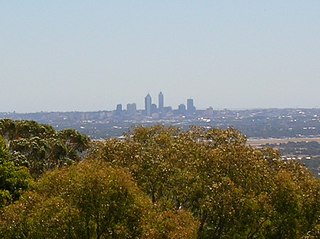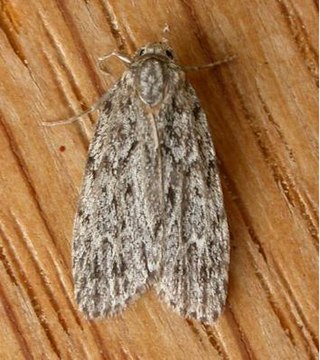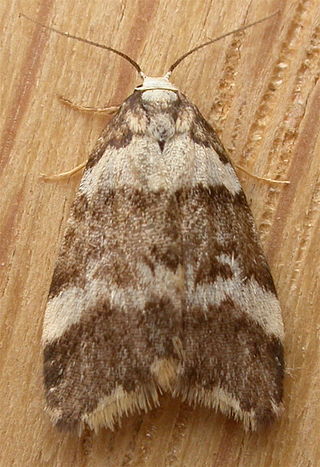
A woodland is, in the broad sense, land covered with woody plants, or in a narrow sense, synonymous with wood, a low-density forest forming open habitats with plenty of sunlight and limited shade. Some savannas may also be woodlands, such as savanna woodland, where trees and shrubs form a light canopy.

The Nullarbor Plain is part of the area of flat, almost treeless, arid or semi-arid country of southern Australia, located on the Great Australian Bight coast with the Great Victoria Desert to its north. It is the world's largest single exposure of limestone bedrock, and occupies an area of about 200,000 square kilometres (77,000 sq mi). At its widest point, it stretches about 1,100 kilometres (684 mi) from east to west across the border between South Australia and Western Australia.

Southwest Australia is a biogeographic region in Western Australia. It includes the Mediterranean-climate area of southwestern Australia, which is home to a diverse and distinctive flora and fauna.

Moree Plains Shire is a local government area in the North West Slopes region of New South Wales, Australia. The northern boundary of the Shire is located adjacent to the border between New South Wales and Queensland. The Shire is located adjacent to the Newell and Gwydir Highways and the North West railway line.

The Swan Coastal Plain in Western Australia is the geographic feature which contains the Swan River as it travels west to the Indian Ocean. The coastal plain continues well beyond the boundaries of the Swan River and its tributaries, as a geological and biological zone, one of Western Australia's Interim Biogeographic Regionalisation for Australia regions. It is also one of the distinct physiographic provinces of the larger West Australian Shield division.

Halone is a genus of moths in the subfamily Arctiinae from southern Asia and Australia. The genus was erected by Francis Walker in 1854.
Proszenie is a village in the administrative district of Gmina Wolbórz, within Piotrków County, Łódź Voivodeship, in central Poland. It lies approximately 4 kilometres (2 mi) south-west of Wolbórz, 12 km (7 mi) north-east of Piotrków Trybunalski, and 40 km (25 mi) south-east of the regional capital Łódź.

Halone coryphoea is a moth of the subfamily Arctiinae first described by George Hampson in 1914. It is found in Australia.

Halone sejuncta, the variable halone, is a moth of the subfamily Arctiinae first described by Rudolf Felder and Alois Friedrich Rogenhofer in 1875. It is found in Australia in Queensland, New South Wales, the Australian Capital Territory, Victoria, Tasmania and South Australia.
Cooke Plains is a settlement in South Australia. It is adjacent to the Dukes Highway on the Adelaide–Melbourne railway about halfway between Tailem Bend and Coomandook, however trains no longer stop there. The town has several businesses and a Soldier's Memorial Hall.

The Alex Halone House in Thermopolis, Wyoming, United States, was built by Finnish immigrant Alex Halone for his personal residence in 1909–1910. Halone, a stonemason, built several stone structures in Thermopolis. Three generations of the Halone family were stonemasons. The grounds include a log Finnish sauna built by Alex and Eugene Halone with assistance from Lauri Suikaonen in 1946–51.

Halone pteridaula, the brown halone, is a species of moth of the subfamily Arctiinae first described by Alfred Jefferis Turner in 1922. It is known from the Australian Capital Territory, New South Wales, Queensland, Tasmania and Victoria, all in Australia.
Halone consolatrix is a moth of the subfamily Arctiinae. It was described by Rudolph Rosenstock in 1899. It is found in Australia.
Halone ebaea is a moth of the subfamily Arctiinae. It was described by George Hampson in 1914. It is found in Australia.
Halone interspersa is a moth of the subfamily Arctiinae. It was described by Thomas Pennington Lucas in 1890. It is found in Australia.
Halone ophiodes, the cryptic halone, is a moth of the subfamily Arctiinae. It was described by Edward Meyrick in 1886. It is found in Australia.
Halone servilis is a moth of the subfamily Arctiinae. It was described by Edward Meyrick in 1886. It is found in Australia.
Halone sinuata, the rock lichen moth, is a moth of the subfamily Arctiinae. It was described by Hans Daniel Johan Wallengren in 1860. It is found in Australia.
Halone sobria is a moth of the subfamily Arctiinae. It was described by Francis Walker in 1854. It is found in Australia.










